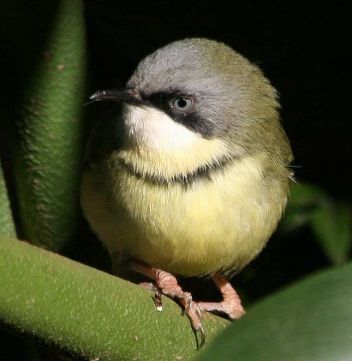- Apalis thoracica
Identification
Length 12-13 cm, mass 8.3-13.1 g.
Adult: Narrow black breastband together with pale eyes separate this species from most others.
Distribution
Eastern and southern Africa: Kenya, Tanzania, Zambia, Mozambique, Malawi, Botswana, Zimbabwe, South Africa, Lesotho, and eSwatini.
Taxonomy
This taxon was recently split: A. fuscigularis (Taita Apalis), A. flavigularis (Yellow-throated Apalis) and A. lynesi (Namuli Apalis) were recognised as separate (and threatened) species[1][2][3].
Subspecies
Eighteen subpecies are recognized. The colours of the crown, back and underparts vary.
- A. t. griseiceps (iringae): South-eastern Kenya (Chyulu Hills) and highlands of Tanzania
- A. t. pareensis: Northern Tanzania (South Pare Mountains)
- A. t. uluguru: North-eastern Tanzania (Uluguru Mountains)
- A. t. murina: North-eastern Tanzania to northern Malawi and adjacent Zambia
- A. t. youngi: South-western Tanzania to north-eastern Malawi and adjacent Zambia
- A. t. whitei: Eastern Zambia to southern Malawi and adjacent Mozambique (Zobue)
- A. t. quarta: North-eastern Zimbabwe (Mount Nyangani) and Mozambique (Mount Gorongoza)
- A. t. arnoldi: Eastern Zimbabwe and adjacent Mozambique
- A. t. rhodesiae: Zimbabwe plateau and north-eastern Botswana
- A. t. flaviventris: South-eastern Botswana to northern and western Transvaal
- A. t. spelonkensis: Eastern and northern Transvaal
- A. t. lebomboensis: North-eastern Zululand (Lebombo Mountains) to eastern eSwatini and southern Mozambique
- A. t. venusta (darglensis): Zululand to Natal, eastern Griqualand and Great Kei River
- A. t. drakensbergensis: South Africa (Drakensberg Mountains to western eSwatini)
- A. t. thoracica: South-eastern Cape Province (Great Kei and Gamtoos River to Umtata)
- A. t. claudei: Southern Cape Province (Knysna to Humansdorp and Beaufort West)
- A. t. capensis: South and south-western Cape Province (Paarl to Oudtshoorn and Mossel Bay)
- A. t. griseopyga: Coastal western Cape Province (Lamberts Bay to Cape Town)
Habitat
Forest edges, moist woodlands and shrublands, gardens.
Behaviour
Singly, in pairs or in groups of up to six individuals. Inquisitive and fairly bold.
Diet
Forages restlessly for invertebrates, gleaned from bark, leaves and flowers; also eats fruit.
Breeding
Monogamous and territorial. The nest is oval or dome-shaped with a side-top entrance; built of fine plant material, lichen, moss and spider web. Two to four eggs are laid August to April. Parasitised by Red-chested Cuckoo and Klaas's Cuckoo.
References
- Clements, J. F., T. S. Schulenberg, M. J. Iliff, S. M. Billerman, T. A. Fredericks, B. L. Sullivan, and C. L. Wood. 2019. The eBird/Clements Checklist of Birds of the World: v2019. Downloaded from http://www.birds.cornell.edu/clementschecklist/download/
- BirdLife International. 2009. The BirdLife checklist of the birds of the world, with conservation status and taxonomic sources. Version 2. Downloaded from http://www.birdlife.org/datazone/species/downloads/BirdLife_Checklist_Version_2.zip [.xls zipped 1 MB].
- Gill, F, M Wright and D Donsker. 2009. IOC World Bird Names (version 2.0). Available at http://www.worldbirdnames.org/.
- Hockey PAR, Dean WRJ & Ryan PG (eds) 2005. Robert's Birds of Southern Africa, 7th edition. John Voelcker Bird Book Fund, Cape Town, South Africa. ISBN 0620340533
- Sinclair I & Ryan P. 2003. Birds of Africa south of the Sahara. Princeton University Press. ISBN 0620207299
Recommended Citation
- BirdForum Opus contributors. (2025) Bar-throated Apalis. In: BirdForum, the forum for wild birds and birding. Retrieved 3 May 2025 from https://www.birdforum.net/opus/Bar-throated_Apalis
External Links
GSearch checked for 2020 platform.





